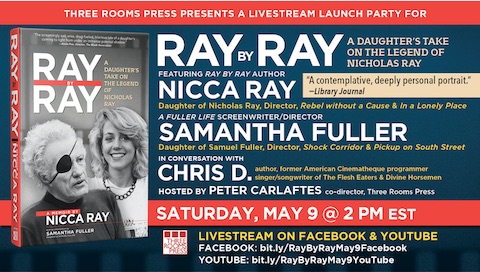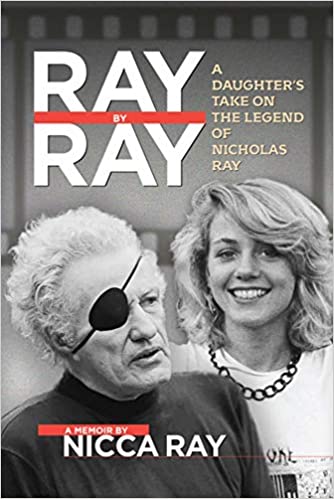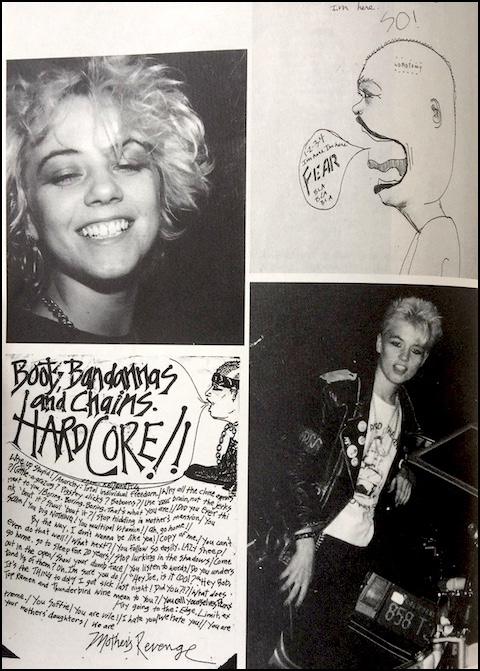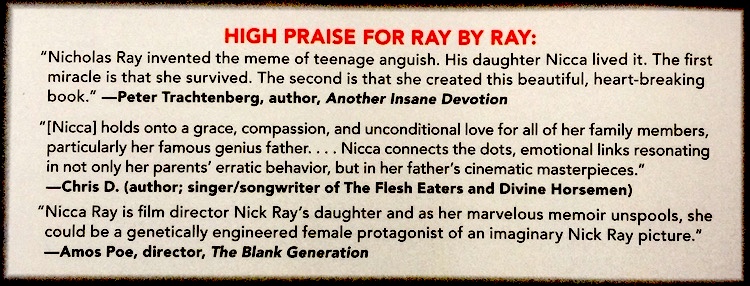
Three Rooms Press has just published RAY BY RAY, a combination memoir-biography by Nicca Ray, daughter of the maverick Hollywood director Nicholas Ray, with an introduction by Samantha Fuller, daughter of another Hollywood maverick, the screenwriter/director Sam Fuller. The publisher will present a livestream book launch Saturday afternoon—May 9 @ 2pm-4pm EST — featuring the two women in a conversation about the careers and legacies of their notorious fathers.
+ + +
Nicca Ray writes that she grew up in Los Angeles not far from where her father shot some of his most famous film, “Rebel Without a Cause.” When she was 14, she got heavily into the L.A. punk scene and spent a decade mimicking her father’s drug and alcohol abuse. A decade later she cleaned up, moved to New York City, and at age 38 graduated from The New School, where she launched her own career in films and theater. Meanwhile, she spent many years researching her father’s life and his deep connections with his two closest mentors Elia Kazan and John Houseman. To write this book she also interviewed friends of her father at length—including Wim Wenders, and Dennis Hopper, and Norman Lloyd—and explored with her half-brother Tony Ray the unusually complicated relationships of her extended family.

RAY BY RAY opens with an exquisitely candid chapter, “Please Allow Me to Introduce Myself”:
“I come from a long line of alcoholics and drug addicts,” Nica Ray tells us. “Aside from alcohol, speed was the drug of choice amongst us. Although I did dabble in heroin, I was squeamish with needles and blood, and so I never made it to full-on junkiedom.”
The chapter continues:
My father, Nick, was notorious for carrying a doctor’s bag full of pharmaceuticals during the height of his career directing twenty movies (not including the films he doctored while under contract at RKO) in sixteen years. By the time I was born his illustrious career was on the skids, a doctor had prescribed methamphetamine to treat his alcoholism, and a nurse was coming to the house to shoot him up. At the same time my mother Betty, his third wife, was ingesting Preludin, an amphetamine that made her mind spin around in circles so quickly she could barely move. After Betty left Nick, she got off the Preludin, but continued popping the caffeine tablets, Vivarin and NoDoze, like candy.
I was five years old and standing in the small living room of the house my mother had called a shack when it became clear to me that I had to have a strong sense of self before achieving success. Otherwise, I’d become my parents. This is the first clear memory I have of childhood.
When Nick came to visit us ten years after my parent’s separation, he brought along his drug dealer who always carried with him the best Bolivian and Peruvian flake. Not that I knew what cocaine was at the time. Hell, I didn’t even know what the tiny silver spoon was that my father had dropped on our living room carpet. When I’d asked my older sister what it was, she looked at me like I was from Mars and said, “Coke, Nicca, coke.”

I started my love affair with speed when I was twelve. First, I tried white crosses, pills that resemble an aspirin tablet but do much more than kill the pain. I graduated to their bigger sister, the time released black beauty, by the time I was fourteen. Two years later I was snorting cocaine practically every day. It was not a problem getting my hands on it. I’d started going to clubs on the Sunset Strip when I was fourteen. There were always men willing to give a pretty girl drugs.
I loved alcohol just as much as I loved speed and would put myself in the same precarious situations to get my hands on another drink that I would to get another line of coke. By the time I was of age I was sober, so I never took a legal drink and therefore had to scam for drinks just as I had to scam for drugs. Another family trait I shared was mixing alcohol and speed. The two just seemed to go hand in hand. Mixing cocaine and liquor really did the trick, though. The coke kept me from getting messy. Without it I was a falling down disaster.
Nick, once a Hollywood golden boy championed by the producer, John Houseman, and the director, Elia Kazan, became a fall down drunk in his later years. The doctor who had prescribed him the methamphetamine believed the speed would keep the alcohol from destroying Nick. It only added to his mania. I knew nothing about Nick’s mania until I was in my forties and started on this search to find out about my father’s career and life, the reason for my parent’s separation and eventual divorce, and ultimately to learn what kind of a man Nicholas Ray was. In so doing I hoped to come to a better understanding of myself.
When I looked into the mirror, there was always a hole where my father was supposed to be. I could see my mother in me, because I had grown up with her, but I had not grown up with my father, in fact I’d only seen him a handful of times, and I was always left with an emptiness, a not knowing. And I needed to know what parts of me came from him because I was his namesake. I had been making attempts to shape my life in his image since I was a teenager running through my high school from cops with their guns drawn. The troublemaker, rebel, non-conformist. I’d gone to many bookstores and stood in the film book aisle reading about what a renegade Nicholas Ray was, reading how he understood the misunderstood, reading about his kinship with the troubled teen.

That was me! The troubled teen. He had been one, too. He’d been kicked out of high school sixteen times after his father died. After Nick died, I dove into a punk rock lifestyle that at first saved me. In the late 1970s it was the only place where it was okay to be an angry girl. The anger I had been feeling since Betty married a second time, putting my sister and I into danger and leaving us both the victim of violent rages and incest, amplified after my father’s death. I met girls who were angry like me, girls who understood. I cut off all of my hair. I dressed in black with chains and spikes. I spent my nights slam dancing (we didn’t call it moshing then) in the pit to bands like Black Flag, The Adolescents and The Circle Jerks. In the mornings my friends and I would count our bruises like they were badges of honor. We didn’t live at home with our parents. We couldn’t get jobs because of the way we looked or keep them because we couldn’t wake up in time. We spent the money we earned panhandling on black beauties and Thunderbird wine or Olde English 40-ounces, instead of food, and eventually I got sick with hepatitis.
Nick’s mother always came to his financial rescue and his three older sisters were always there to help him pick up the pieces. Nick would never risk actual homelessness, not even later in his drug addled life. He had directed the masterpiece, “Rebel Without a Cause,” and that was the calling card that would always be his savior.
I had no such calling card to save me. Everyone in my family was always scrambling to save themselves. I have one full-blooded sister, Julie, and two half-brothers, Tony and Tim. Tony is Nick’s son from his first marriage to the writer, Jean Evans. Tim is Nick’s son with his second wife, the actress Gloria Grahame. If you’re a film buff you may recognize her as Ginny Tremaine in “Crossfire,” Violet Bick in “It’s a Wonderful Life,” or as Rosemary Bartlow in “The Bad and the Beautiful.” If you aren’t a film buff but are big on Hollywood scandals of the 1950s you’ve probably heard about Gloria Grahame marrying Nick Ray’s first son, Tony, eight years after she divorced Nick. And if you haven’t heard, I am here to tell you.
With that kind of opening, I’m betting the rest of RAY BY RAY will keep me reading.

WOW! I’ve just read a segment from what may turn out to be a bunker-buster of a book!